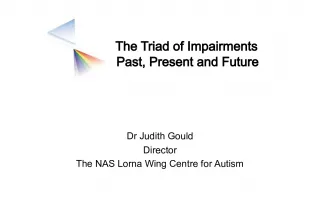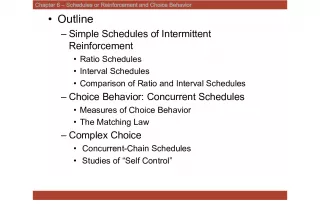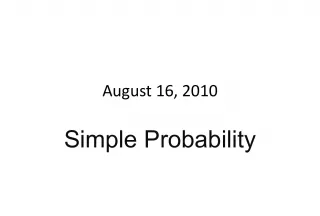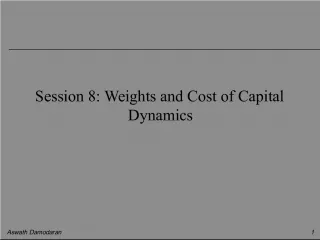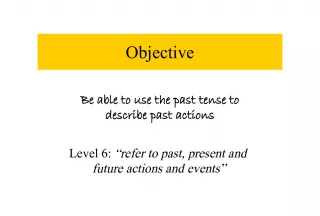Understanding Intertemporal Choice and Present and Future Values in Microeconomics


This article explores the concept of intertemporal choice in microeconomics, specifically how individuals distribute income over time and make decisions about saving and borrowing. It also covers the calculation of present and future values based on interest rates.
- Uploaded on | 0 Views
-
 braedon
braedon
About Understanding Intertemporal Choice and Present and Future Values in Microeconomics
PowerPoint presentation about 'Understanding Intertemporal Choice and Present and Future Values in Microeconomics'. This presentation describes the topic on This article explores the concept of intertemporal choice in microeconomics, specifically how individuals distribute income over time and make decisions about saving and borrowing. It also covers the calculation of present and future values based on interest rates.. The key topics included in this slideshow are intertemporal choice, income distribution, saving, borrowing, present value, future value, interest rate, financial arithmetic, microeconomics,. Download this presentation absolutely free.
Presentation Transcript
1. Hal Varian Intermediate Microeconomics Chapter Ten Intertemporal Choice
2. Intertemporal Choice u Persons often receive income in lumps; e.g. monthly salary. u How is a lump of income spread over the following month (saving now for consumption later)? u Or how is consumption financed by borrowing now against income to be received at the end of the month?
3. Present and Future Values u Begin with some simple financial arithmetic. u Take just two periods; 1 and 2. u Let r denote the interest rate per period.
4. Future Value u E.g., if r = 0.1 then $100 saved at the start of period 1 becomes $110 at the start of period 2. u The value next period of $1 saved now is the future value of that dollar.
5. Future Value u Given an interest rate r the future value one period from now of $1 is u Given an interest rate r the future value one period from now of $m is
6. Present Value u Suppose you can pay now to obtain $1 at the start of next period. u What is the most you should pay? u $1? u No. If you kept your $1 now and saved it then at the start of next period you would have $(1+r) > $1, so paying $1 now for $1 next period is a bad deal.
7. Present Value u Q: How much money would have to be saved now, in the present, to obtain $1 at the start of the next period? u A: $m saved now becomes $m(1+r) at the start of next period, so we want the value of m for which m(1+r) = 1 That is, m = 1/(1+r), the present-value of $1 obtained at the start of next period.
8. Present Value u The present value of $1 available at the start of the next period is u And the present value of $m available at the start of the next period is
9. Present Value u E.g., if r = 0.1 then the most you should pay now for $1 available next period is u And if r = 0.2 then the most you should pay now for $1 available next period is
10. The Intertemporal Choice Problem u Let m 1 and m 2 be incomes received in periods 1 and 2. u Let c 1 and c 2 be consumptions in periods 1 and 2. u Let p 1 and p 2 be the prices of consumption in periods 1 and 2.
11. The Intertemporal Choice Problem u The intertemporal choice problem: Given incomes m 1 and m 2 , and given consumption prices p 1 and p 2 , what is the most preferred intertemporal consumption bundle (c 1 , c 2 )? u For an answer we need to know: the intertemporal budget constraint intertemporal consumption preferences.
12. The Intertemporal Budget Constraint u To start, lets ignore price effects by supposing that p 1 = p 2 = $1.
13. The Intertemporal Budget Constraint u Suppose that the consumer chooses not to save or to borrow. u Q: What will be consumed in period 1? u A: c 1 = m 1 . u Q: What will be consumed in period 2? u A: c 2 = m 2 .
14. The Intertemporal Budget Constraint c 1 c 2 m 2 m 1 0 0
15. The Intertemporal Budget Constraint c 1 c 2 So (c 1 , c 2 ) = (m 1 , m 2 ) is the consumption bundle if the consumer chooses neither to save nor to borrow. m 2 m 1 0 0
16. The Intertemporal Budget Constraint u Now suppose that the consumer spends nothing on consumption in period 1; that is, c 1 = 0 and the consumer saves s 1 = m 1 . u The interest rate is r. u What now will be period 2s consumption level?
17. The Intertemporal Budget Constraint u Period 2 income is m 2 . u Savings plus interest from period 1 sum to (1 + r )m 1 . u So total income available in period 2 is m 2 + (1 + r )m 1 . u So period 2 consumption expenditure is
18. The Intertemporal Budget Constraint u Period 2 income is m 2 . u Savings plus interest from period 1 sum to (1 + r )m 1 . u So total income available in period 2 is m 2 + (1 + r )m 1 . u So period 2 consumption expenditure is
19. The Intertemporal Budget Constraint c 1 c 2 m 2 m 1 0 0 the future-value of the income endowment
20. The Intertemporal Budget Constraint c 1 c 2 m 2 m 1 0 0 is the consumption bundle when all period 1 income is saved.
21. The Intertemporal Budget Constraint u Now suppose that the consumer spends everything possible on consumption in period 1, so c 2 = 0. u What is the most that the consumer can borrow in period 1 against her period 2 income of $m 2 ? u Let b 1 denote the amount borrowed in period 1.
22. The Intertemporal Budget Constraint u Only $m 2 will be available in period 2 to pay back $b 1 borrowed in period 1. u So b 1 (1 + r ) = m 2 . u That is, b 1 = m 2 / (1 + r ). u So the largest possible period 1 consumption level is
23. The Intertemporal Budget Constraint u Only $m 2 will be available in period 2 to pay back $b 1 borrowed in period 1. u So b 1 (1 + r ) = m 2 . u That is, b 1 = m 2 / (1 + r ). u So the largest possible period 1 consumption level is
24. The Intertemporal Budget Constraint c 1 c 2 m 2 m 1 0 0 is the consumption bundle when all period 1 income is saved. the present-value of the income endowment
25. The Intertemporal Budget Constraint c 1 c 2 m 2 m 1 0 0 is the consumption bundle when period 1 borrowing is as big as possible. is the consumption bundle when period 1 saving is as large as possible.
26. The Intertemporal Budget Constraint u Suppose that c 1 units are consumed in period 1. This costs $c 1 and leaves m 1 - c 1 saved. Period 2 consumption will then be
27. The Intertemporal Budget Constraint u Suppose that c 1 units are consumed in period 1. This costs $c 1 and leaves m 1 - c 1 saved. Period 2 consumption will then be which is slope intercept
28. The Intertemporal Budget Constraint c 1 c 2 m 2 m 1 0 0 is the consumption bundle when period 1 borrowing is as big as possible. is the consumption bundle when period 1 saving is as large as possible.
29. The Intertemporal Budget Constraint c 1 c 2 m 2 m 1 0 0 slope = -(1+r)
30. The Intertemporal Budget Constraint c 1 c 2 m 2 m 1 0 0 Saving Borrowing slope = -(1+r)
31. The Intertemporal Budget Constraint is the future-valued form of the budget constraint since all terms are in period 2 values. This is equivalent to which is the present-valued form of the constraint since all terms are in period 1 values.
32. The Intertemporal Budget Constraint u Now lets add prices p 1 and p 2 for consumption in periods 1 and 2. u How does this affect the budget constraint?
33. Intertemporal Choice u Given her endowment (m 1 ,m 2 ) and prices p 1 , p 2 what intertemporal consumption bundle (c 1 *,c 2 *) will be chosen by the consumer? u Maximum possible expenditure in period 2 is so maximum possible consumption in period 2 is
34. Intertemporal Choice u Similarly, maximum possible expenditure in period 1 is so maximum possible consumption in period 1 is
35. Intertemporal Choice u Finally, if c 1 units are consumed in period 1 then the consumer spends p 1 c 1 in period 1, leaving m 1 - p 1 c 1 saved for period 1. Available income in period 2 will then be so
36. Intertemporal Choice rearranged is This is the future-valued form of the budget constraint since all terms are expressed in period 2 values. Equivalent to it is the present-valued form where all terms are expressed in period 1 values.
37. The Intertemporal Budget Constraint c 1 c 2 m 2 /p 2 m 1 /p 1 0 0
38. The Intertemporal Budget Constraint c 1 c 2 m 2 /p 2 m 1 /p 1 0 0
39. The Intertemporal Budget Constraint c 1 c 2 m 2 /p 2 m 1 /p 1 0 0
40. The Intertemporal Budget Constraint c 1 c 2 m 2 /p 2 m 1 /p 1 0 0 Slope =
41. The Intertemporal Budget Constraint c 1 c 2 m 2 /p 2 m 1 /p 1 0 0 Saving Borrowing Slope =
42. Price Inflation Define the inflation rate by where For example, = 0.2 means 20% inflation, and = 1.0 means 100% inflation.
43. Price Inflation We lose nothing by setting p 1 =1 so that p 2 = 1+ . u Then we can rewrite the budget constraint as
44. Price Inflation rearranges to so the slope of the intertemporal budget constraint is
45. Price Inflation u When there was no price inflation (p 1 =p 2 =1) the slope of the budget constraint was -(1+r). Now, with price inflation, the slope of the budget constraint is -(1+r)/(1+ ). This can be written as is known as the real interest rate .
46. Real Interest Rate gives For low inflation rates ( 0), r - . For higher inflation rates this approximation becomes poor.
47. Real Interest Rate
48. Comparative Statics u The slope of the budget constraint is The constraint becomes flatter if the interest rate r falls or the inflation rate rises (both decrease the real rate of interest).
49. Comparative Statics c 1 c 2 m 2 /p 2 m 1 /p 1 0 0 slope =
50. Comparative Statics c 1 c 2 m 2 /p 2 m 1 /p 1 0 0 slope =
51. Comparative Statics c 1 c 2 m 2 /p 2 m 1 /p 1 0 0 slope = The consumer saves.
52. Comparative Statics c 1 c 2 m 2 /p 2 m 1 /p 1 0 0 slope = The consumer saves. An increase in the inflation rate or a decrease in the interest rate flattens the budget constraint.
53. Comparative Statics c 1 c 2 m 2 /p 2 m 1 /p 1 0 0 slope = If the consumer saves then saving and welfare are reduced by a lower interest rate or a higher inflation rate.
54. Comparative Statics c 1 c 2 m 2 /p 2 m 1 /p 1 0 0 slope =
55. Comparative Statics c 1 c 2 m 2 /p 2 m 1 /p 1 0 0 slope =
56. Comparative Statics c 1 c 2 m 2 /p 2 m 1 /p 1 0 0 slope = The consumer borrows.
57. Comparative Statics c 1 c 2 m 2 /p 2 m 1 /p 1 0 0 slope = The consumer borrows. A fall in the inflation rate or a rise in the interest rate flattens the budget constraint.
58. Comparative Statics c 1 c 2 m 2 /p 2 m 1 /p 1 0 0 slope = If the consumer borrows then borrowing and welfare are increased by a lower interest rate or a higher inflation rate.
59. Valuing Securities u A financial security is a financial instrument that promises to deliver an income stream. u E.g.; a security that pays $m 1 at the end of year 1, $m 2 at the end of year 2, and $m 3 at the end of year 3. u What is the most that should be paid now for this security?
60. Valuing Securities u The security is equivalent to the sum of three securities; the first pays only $m 1 at the end of year 1, the second pays only $m 2 at the end of year 2, and the third pays only $m 3 at the end of year 3.
61. Valuing Securities u The PV of $m 1 paid 1 year from now is u The PV of $m 2 paid 2 years from now is u The PV of $m 3 paid 3 years from now is u The PV of the security is therefore
62. Valuing Bonds u A bond is a special type of security that pays a fixed amount $x for T years (its maturity date ) and then pays its face value $F. u What is the most that should now be paid for such a bond?
63. Valuing Bonds
64. Valuing Bonds u Suppose you win a State lottery. The prize is $1,000,000 but it is paid over 10 years in equal installments of $100,000 each. What is the prize actually worth?
65. Valuing Bonds is the actual (present) value of the prize.
66. Valuing Consols u A consol is a bond which never terminates, paying $x per period forever. u What is a consols present-value?
67. Valuing Consols
68. Valuing Consols Solving for PV gives
69. Valuing Consols E.g. if r = 0.1 now and forever then the most that should be paid now for a console that provides $1000 per year is

